Böötle - the ultimate guide to Swiss rivers
Böötle is a super popular summer activity for families and friends. It's a Swiss German term for floating down Swiss rivers on an inflatable boat, air mattress, or even a swim ring.
What do you do while Böötle-ing? You hop on your floating device at a spot along the river and let the current carry you. You can get off wherever you like and take a train or bus back to where you started. Don't forget your waterproof bag with water, dry clothes, shoes, and anything else you need for the return trip.
This is especially popular in Zürich, where during the summer, many friends, families, and couples float down the Limmat on small inflatable boats, pink flamingos, or swim rings.
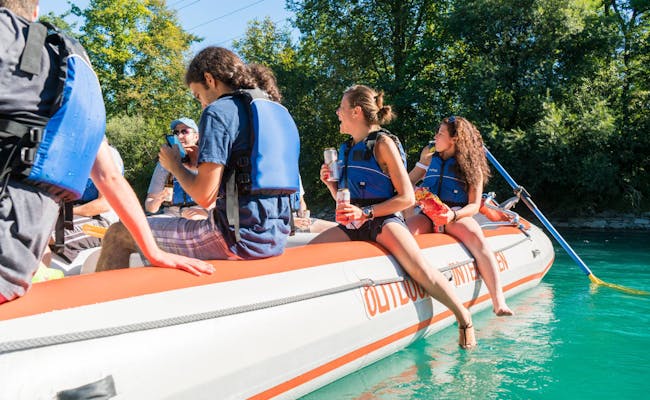 Aareböötle boat trip (Photo: Outdoor Interlaken)
Aareböötle boat trip (Photo: Outdoor Interlaken)
You are spoiled for choice when it comes to choosing the right route and the right river. At the bottom of the page you will find important information about equipment, safety and specific dangers when boating in the FAQ. Above all, it is important to start the exit in good time before danger spots, power stations and weirs.
When choosing the right route and river for your adventure, you're faced with plenty of options. We’ve gathered important information in the FAQs at the bottom about equipment, safety, and specific dangers while boating. It’s especially important to start the exit before danger areas, power plants, and weirs in good time.
The ten most beautiful boating tours
There are numerous popular river tours in Switzerland. Here are the 10 most beautiful boating tours summarized for you:
Aare: Thun to Bern (3-4 hours): This is the most famous and popular Aare rafting route, starting from Thun Schwäbis through the legendary Uttigen rapids to Bern. This stretch can also be shortened (Uttigen-Camping Eichholz)
Ticino: Cresciano to Arbedo (1.5 to 2 hours): The river starts off partly wild, passing forested slopes and gravel banks, with views of the Ticino Alps.
Reuss: Bremgarten to Gebenstorf/Windisch (4 hours): A scenic route that requires a lot of attention due to rapids and rocks, as well as a weir behind Bremgarten; it can be shortened in Mellingen.
Rhein: Stein am Rhein to Schaffhausen (3.5 to 4.5 hours): Enjoy a leisurely trip along forests, hills, and charming villages to Schaffhausen, home to the magnificent Rhine Falls.
Linth: Wesen to Schmerikon (3 to 4 hours): This tour connects Lake Walensee with Lake Obersee.
Limmat: Zurich to Dietikon (2 to 2.5 hours): This stretch is frequently traveled and can safely be started after the Höngger weir.
Saane/Aare: Gümmenen to Aarberg (3-4 hours): The journey goes from the Saane into the Aare, passing through a nature reserve (swimming is prohibited there).
Reuss: Sins to Rottenschwil (3-4 hours): The stretch on the Upper Reuss can already be started from Gisikon, with very few danger spots.
Rhein: Neuhausen am Rheinfall to Rheinau (3-4 hours): The impressive Rhine Falls can be admired at the start of a romantic tour to the Rheinau Abbey.
Rhone: Geneva, Pont Sous-Terre – Geneva, Le Lignon (2 to 3 hours): This boating route takes you through largely unknown parts of the Geneva region, with beautiful bridges along the way.
Böötle: Boat rental and guided tours
Not everyone wants to buy their own rubber boat right away to pursue this recreational sport. A good alternative are boat rentals, which often even bring and fetch the boats. And for people who don't want to take care of anything themselves, there are guided Böötle.
The organizers have safety certification and public liability insurance. They offer certain routes, guide the rubber boats and watch out for obstacles and dangers. Both boat rentals and providers of guided tours are listed below for each river.
Guided tours are available between May and the end of October, depending on weather conditions.
 Aareböötle Boat Trip (Photo: Outdoor Interlaken)
Aareböötle Boat Trip (Photo: Outdoor Interlaken)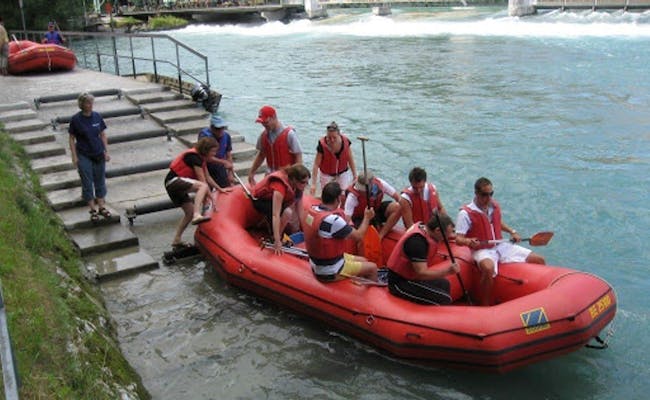 Aareböötle Boat Trip (Photo: Marina Travel)
Aareböötle Boat Trip (Photo: Marina Travel)Aare Boating
On the 27 km stretch between Thun and Bern, you'll find plenty of inflatable boats enjoying the summer water. It's no surprise, as this section is one of the most popular in Switzerland. In 2011, there were 598 boats with 1,214 participants, which set a world record and earned a spot in the Guinness Book.
But you can also float along with your raft on the Kallnach and Hagneck Canal, which has no danger spots.
The route between Schwellenmätteli and the Felsenau dam is also available for boating, and it offers a nice, peaceful experience.
Between Wohlensee and Aargau, there's a boating stretch that's seen as a sporty alternative. This route is more of a rafting path and not for the lazy. You’ll need to paddle together at full speed to make progress since the Aare flows quite slowly here.
Additionally, here are eight more suitable stages for boating along the total 288 km of the Aare, found between Biel (Nidau) and Full/Reuenthal:
- On the first segment from Nidau to Büren, you'll travel about 12 km along the canal.
- If that's not enough for you, you can paddle 17 km from Büren to Solothurn.
- From Solothurn to Wangen a.A. is another 10 km through beautiful natural scenery, with a historical bridge and old town at the destination.
- The 17 km stretch from Wangen a.A. to Murgenthal is also easily manageable.
- From Murgenthal to Olten, the 12 km will require some good technique from you.
- For the stretch from Olten to Aarau (14 km), having good fitness is a plus.
- The section from Aarau to Brugg (18 km) will challenge you physically as well.
- You’ll also need a decent level of fitness between Brugg and Full-Reuenthal (19 km). In this segment, both the Reuss and the Limmat flow into the Aare, which finally merges with the Rhine at Full-Reuenthal.
Water level Aare: The recommended flow rate is less than 400 m³/s in Brügg.
- Boating from Thun via Swiss Activities
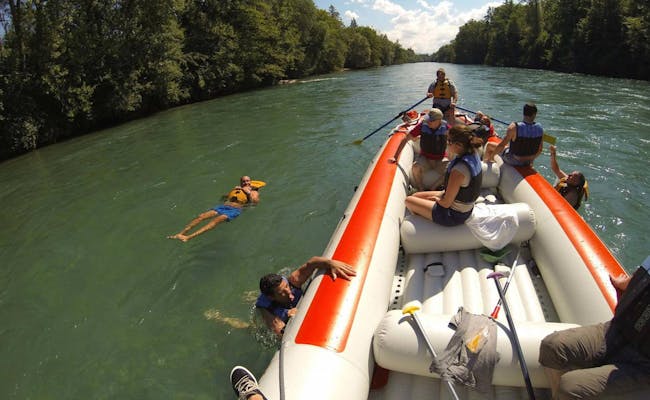 Aareböötle boat trip (Photo: Outdoor Interlaken).
Aareböötle boat trip (Photo: Outdoor Interlaken).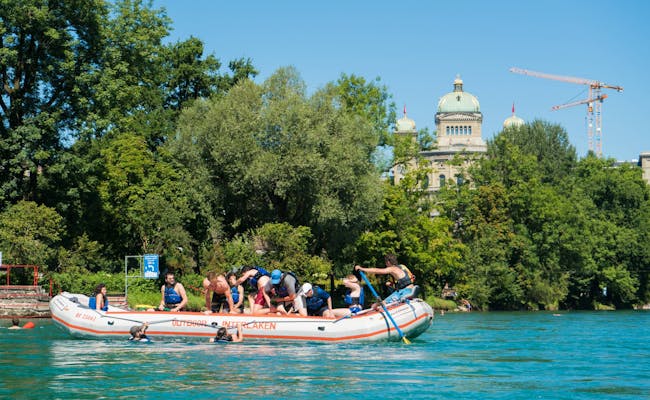 Aareböötle boat trip (Photo: Outdoor Interlaken).
Aareböötle boat trip (Photo: Outdoor Interlaken).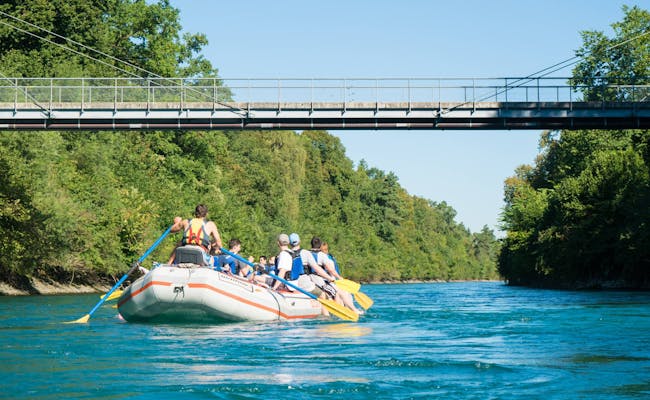 [object Object]
[object Object]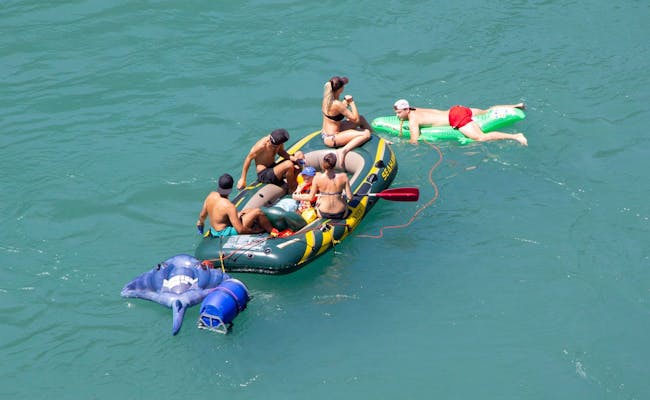 Aareböötle (Photo: aarelauf.ch)
Aareböötle (Photo: aarelauf.ch)Boarding points for the Aare-Böötle
You should pay attention to the usual entry points for the Böötle. They are particularly suitable and have proven themselves.
The entry point in Thun is at Allmund-Schwäbis on the right-hand side of the river, behind the Regiebrücke bridge by the Bellevue restaurant. Schwäbis railroad station (Steffisburg) is right next to it.
There is another entry point in Uttigen after the railroad bridge on the left (5 minutes from the station).
In Bern the boarding point is in Schlipf at Schwellenmätteli, Dalmaziquai 11, right next to the Schwellenmätteli restaurants (5 min from the station).
In Worblaufen you will find the entry point 100 m after the Tiefenaubrücken bridges on the right (5 min from the station).
In Wohlensee you can generally get in anywhere. One possibility is the Wohleibrücke bridge, which is very suitable for boarding.
In Nidau am Bielersee you will find the entry point for Biel below the lock. The parking lot and WC are close by. The next entry point is near the Altreu information center at the bend in the river.
In Wangen a.A. you get in next to the Städtli bridge.
In Aarwangen at the Schlipf in front of the pontoon clubhouse, you can get in from the left before the castle
In Murgenthal at the steps in front of the Aare bridge from the right.
Dangerous spots at Böötle and nature reserves in the Aare River
About five kilometers after the start in Thun, you reach the railroad bridge at Uttigen with the infamous Uttigen wave. Here you have to distribute the weights in the boat evenly and approach the wave in the middle.
Course ships and occasional ships you must regularly avoid and at ferry points a central driving is announced.
At Münsingen dead wood and shallows have to be taken into account.
For a stretch "around Bern", the Stauwehr Engehalde must be bypassed.
At Büsen, navigation of the Aare side arm "Häftli " is not permitted from spring to autumn.
Between Wangen a.A. and Murgenthal you will pass through two nature reserves where it is forbidden to enter or leave the water. Before the power station Wynau, the Aarestau Wynau and the old gravel pit Schwarzhäusern are such an area. You are allowed to drive through, but you have to keep a distance of ten meters to the shore. The same applies to the "Vogelraupfi" between Berken and Bannwil. You must drive around the island at a distance of at least 50 meters to the south.
After Wangen there are more and more hydroelectric power stations and before the respective weirs you absolutely have to ditch. Shortly before Aarwangen you reach the Bannwill power station (bypass on the left bank), after Aarwangen the Wynau/Schwarzhäusern power station (also bypass on the left bank), after Wolfwil comes the Aare-Cheer. You have to watch out for the waves! After Solothurn you reach the next power station: Ruppoldingen. Here you have to go around to the right.
Further danger spots are those of the Kehrwasser Aare-Waage near Aarburg and the Felsens Chessiloch before the wooden bridge Olten. The Aare is forced to make a sudden left turn at Aarburg by a rock spur. This creates a large sweeping water - called "Woog". The water flows back through the vortex. It is best to go around the Woog on the left side.
After Olten you drive between Trimbach and Winznau into the Kraftwerkskanal (power station Olten-Gösgen). Because of a current towards the weir, you have to drive entirely left along the bank.
The weir in Aarau (Rüchlig power station) must be approached carefully. The disembarkation requires special care. It is best to go right, because of the current towards the weir. Several boats should land one after the other.
In Brugg the rubber boat has to be carried for about 1,200 meters. For safety reasons, the deep and wild gorge should not be navigated.
The estuary of the Aare-Reuss-Limmat is called Water Castle. All islands belonging to it may not be entered
At the Klingnau Reservoir there is a protected area of international importance for waterfowl and migratory birds. You have to drive around all nature protection zones with a distance of 50 m and you have to follow the given access to the disembarkation point. In general, you are allowed to pass through the protected area, but not to stop or land.
Landing Spots for Aare-Böötle
The following landing spots have been tested and should be adhered to for safety reasons.
- In Bern, the official landing area is at the Dalmazibrücke after the Marzili Bad on the left bank of the river.
- At the dam Felsenau/Wyler, you need to exit and can then re-enter the water.
- Other landing spots are available before the Muribad and at Eichholz. Between the Felsenau dam and Wohlensee, you can land at Zehndermätteli, after the Felsenau bridge, at Neubrügg, and at Halenbrücke as well as after the Hinterkappelen bridge.
- In Aarberg, the best spot to land is about 150 meters before the dam bridge on the left side of the river. You can reach the Aarberg train station in ten minutes from here.
- In Büren, the canal connects with the Alte Aare. Shortly thereafter, you can exit on the right side behind the bridge. There are restaurants, a supermarket, and a pharmacy nearby. The parking lot is 300 meters away, and the train station is 500 meters away. The regional train takes 19 minutes to return to Biel.
- In Solothurn, you exit on the left side. You can reach the train station in just a few minutes via the bridge. The train takes 23 minutes to return to Biel.
- In Murgenthal (Fahracker), exit on the stairs to the right before the Aare bridge as soon as you spot the wooden bridge from a distance. Access to Fahracker is only permitted until the no-entry sign. The train station is just a two-minute walk away. Additional exits can be found in Aarburg at the Aare promenade to the right (1 minute to the bus) and in Olten near the beach (Strandbad), shortly before the wooden bridge, to the left. The train station is about a ten-minute walk over the wooden bridge.
- The landing spot in Aarau is located before the Kettenbrücke to the right at the watersports club, just before the Flösserplatz. It takes you about 15 minutes to walk to the train station from here. In Altenburg near Brugg, exit to the right and walk about 18 minutes to the train station.
- In Full-Reuenthal, you should land on the left side at Jüppenweg no later than after the confluence with the Rhine. From here, it’s a 1-2 minute walk to the bus stop (147). The ferry as a connector is located directly at the landing spot. The public transport journey from Full back to Biel takes about 1 hour and 40 minutes.
 Aareböötle Equipment (Photo: aarelauf.ch)
Aareböötle Equipment (Photo: aarelauf.ch)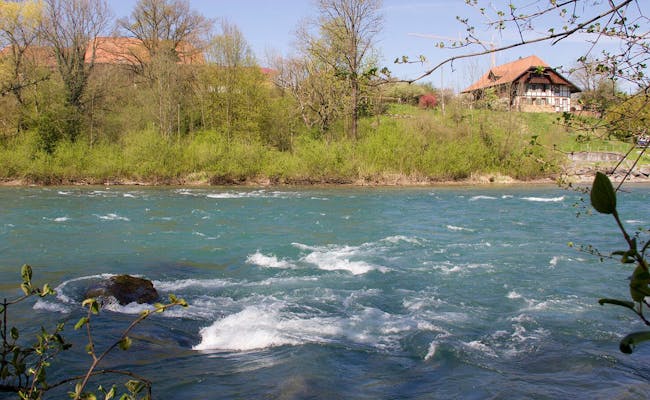
Protected areas:
- Between Wangen a.A. and Murgenthal you will pass through two nature reserves where it is forbidden to enter or leave the water.
- The Aare-Reuss-Limmat estuary is known as the Wasserschloss. All the islands that belong to it may not be entered.
- The Klingnau reservoir is a protected area of international importance for waterfowl and migratory birds. You must drive around all nature conservation zones at a distance of 50 m and follow the specified access route to the disembarkation point. In general, you are allowed to drive through the protected area, but not to stop or land.
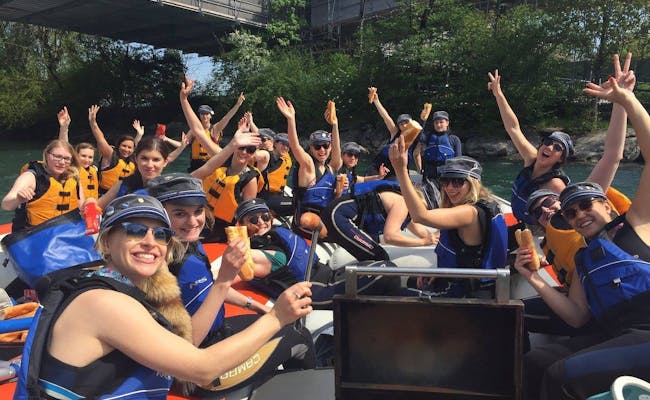 Aareböötle Boat Trip - (Photo: Outdoor Interlaken)
Aareböötle Boat Trip - (Photo: Outdoor Interlaken)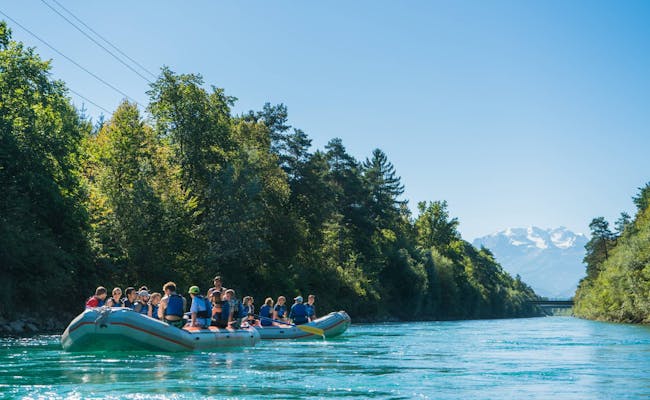 Aareböötle Boat Trip - (Photo: Outdoor Interlaken)
Aareböötle Boat Trip - (Photo: Outdoor Interlaken)Limmat-Boating
The most popular route for Limmat boating is the stretch between Zurich and Dietikon. It's well connected to public transport and always busy due to its proximity to the big city. The interesting mix of urbanity and beautiful nature provides a great recreational value.
The Limmat is heavily used over the 10 km between Zurich and Dietikon, but you can also start boarding at the Höngger Wehr, saving you the trouble of carrying your boat around the weir. The riverbanks, designed naturally by beavers, start after the Werdinsel beyond the weir. The further stretch beyond Baden ends at the latest at Kappelerhof.
Entry Points for Limmat Boating
A popular entry point is the staircase on the right side of Wipkingerpark in Zurich. It’s directly reachable by tram line 13.
Accessible by bus and tram. Right after the Höngger Wehr, there’s another boarding spot. This is the location that can also be reached from the left side after carrying the boats.
Hazardous Areas for Boating on the Limmat
The Höngger Wehr is very dangerous. People often mishandle the exit here, missing their chance to get out. The exit point before the Höngger Wehr is located on the left side.
At Mühliwehr, you pass on the left. You must also navigate around the weir for the Kraftwerk Aue and exit before the weir at Kraftwerk Kapellerhof.
On the stretch from Wipkingerpark to Höngger Wehr (lower Limmat), the safety information from the city of Zurich advises against using inflatable boats if the discharge exceeds 100 m³/s.
Exit Points for Limmat Boating: Dietikon and Glanzenberg
The exit options before the Höngg Weir are signposted on the left bank. You will exit at the concrete ramp. You’ll need to carry the boats 60 meters on foot.
Allmend Glanzenberg is a convenient exit as it offers plenty of space, toilets, and direct access to the S-Bahn station Glanzenberg.
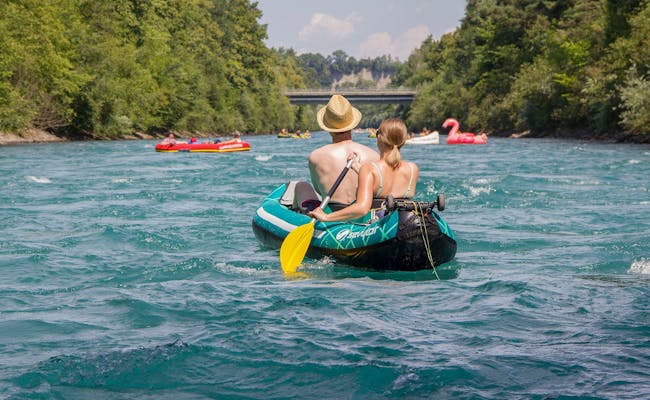 Aareböötle Heimberg Uetendorf (Photo: aarelauf.ch)
Aareböötle Heimberg Uetendorf (Photo: aarelauf.ch)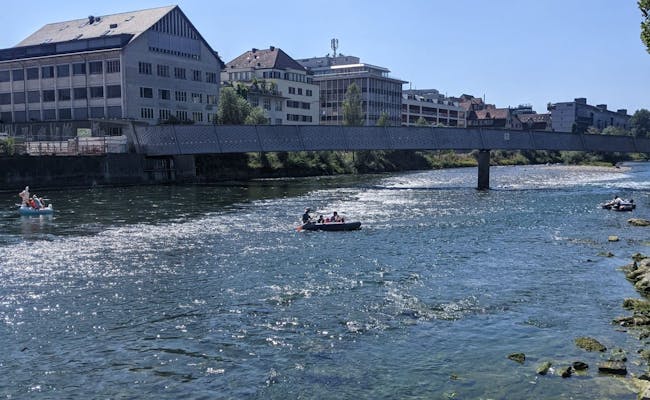
Reuss Rafting
The gently winding Reuss is a popular choice for river tours with rubber boats. The Reuss is an untouched body of water in many places. It offers plenty of calm but also has adventurous passages.
During your trip, you'll pass by some impressive bridges, like the beautiful wooden Zoll Bridge near Sins. You need to be aware of artificial obstacles and some weirs; otherwise, you can easily explore the Reuss with your inflatable boat. Besides calm stretches, there are also sections with strong currents.
Particularly the Lower Reuss requires your full attention. Always pay attention to warning signals and clarify possible entry and exit points in advance. Almost all stretches have options for an early exit.
The stretch between Bremgarten and Gebenstorf is a popular rafting route on the Reuss. It's 24 km long and belongs to the Lower Reuss. There are two more routes on the Upper Reuss between Sins and Rottenschwil as well as Gisikon and Rottenschwil.
The Reuss is the fourth largest river in Switzerland. Since it’s a glacial river, there are often higher water levels in June and July, especially after additional rainfall. So, rafting can be quite risky during these weather conditions.
Reuss Rafting Lower Reuss:
The Lower Reuss is one of the most beautiful river stretches.
Entry Point Bremgarten, Bruggmühle
- The usual entry point for rafting on the Lower Reuss is located in Bremgarten. You’ll find the launch area by the Bruggmühle power plant, not far from the large casino parking lot. You can easily inflate your boats at the casino and use the ramp at the Bruggmühle launch area to put in.
- Apart from the “Casino” parking lot, you can also use the “Isenlauf” parking lot, which is also close to the Bruggmühle launch area.
Hazard Areas
- Honeggerweir after Bremgarten: about 1.5 km after starting in Bremgarten, you'll come to an island in the river. The left river arm has a surf wave extending across the entire river arm, which can only be navigated by whitewater paddlers. So, you go down the right river arm. Here, there’s a significant rapid that you should note. You need experience for this.
- The river winds through wooded areas with limited development. You’ll encounter larger boulders, dead wood, but also some rapids and whirlpools in the riverbed along the way. They can be easily avoided if you stay alert and drive predictively. In Gnadenthal, there’s a ** that’s better to navigate around on the right. Additionally, there are rapids in the water near Gnadenthal.**
**#### Exit Points Gnadenthal, Mellingen, Gebenstorf
- Mellingen is an exit point reached after about two hours. You can pull out at Schlössli Iberg.
- The regular exit point for rafting is located about 1.5 hours further just before a weir in Gebenstorf. This spot is also used by boat rentals. However, you’ll need a special access permit for the Reussbädli. Soon after the Reussbädli, you’ll encounter the dangerous weir of the Windisch Spinning Mill, which has a warning sign.
- Boats can be loaded next to the meadow. However, parking is not allowed here or in the residential area. You can access the boat landing area via Road 3, the connecting road from Gebenstorf to Windisch. Just before the bridge, turn right onto Birmenstorfer Street and continue down Bad Street to the end, where the meadow is located.
- For short trips, people often use Gnadenthal or Stetten as exit points. This spot is also popular for a picnic break by other rafters.
- On guided multi-day trips, Stilli or Sulz are also visited as more distant destinations beyond Gebenstorf.
Reuss Rafting Upper Reuss:
The Upper Reuss connects the locations Gisikon, Sins to Rottenschwil.
Entry Points Sins, Gisikon, rarely Perlen, Mühlau
- The launch point is located in Sins near the historic Reuss Bridge Sins-Hünenberg. The entry is next to the Zoll Bridge restaurant, about 50 m downstream of the bridge. You’ll find the nearest parking lot and a parking garage on the other side of the river at the train station. You can reach the train station from the entry point via Zollweid, Road 25, and Bahnhofstrasse.
- In Gisikon-Root, behind the Gasthof Tell, you’ll find the Gisikon entry point, which you can easily reach by bus or train. Parking at the Gasthof Tell will inevitably lead to a ticket, as the parking spots are reserved exclusively for restaurant guests.
- Additional entry points are found in Perlen (after the weir) and in Mühlau.
Hazard Areas
There are no particular hazard areas on the route. In Ottenbach at the diversion weir, you should stay to the left. Special care is required when encountering commercial ships.
Exit Points Rottenschwil, Ottenbach, Bremgarten
The most popular exit point is Rottenschwil, left before the Reuss Bridge. Both the parking lot and bus stop Rottenschwil/Hecht are located directly at the exit. However, you can also exit in Ottenbach beforehand. You must exit before the Bremgarten power plant because of the weir.
**
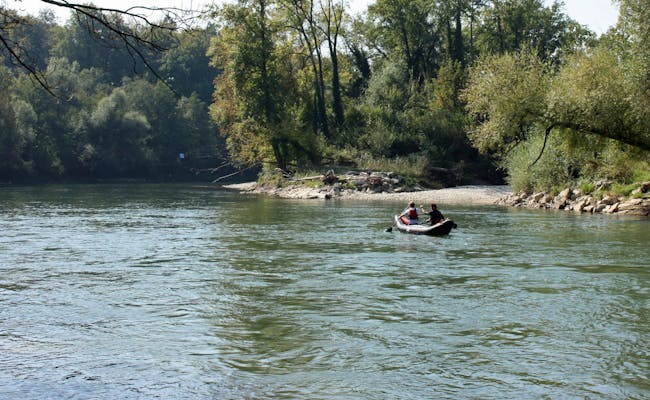 Reuss
Reuss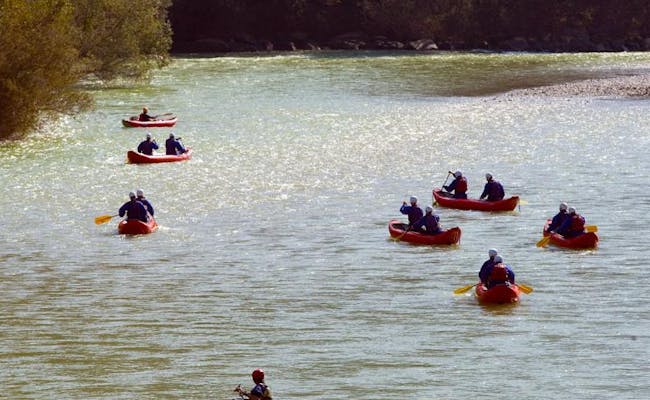 multiple inflatable boats Swissraft (Photo: Swissraft Ticino Tourism Agency ATT SA)
multiple inflatable boats Swissraft (Photo: Swissraft Ticino Tourism Agency ATT SA)Rhein-Boating
The most popular spot for boating on the Rhine is the section between Stein am Rhein and Schaffhausen. It's about 18 km long. Diessenhofen is roughly in the middle and can also be used as a landing spot. The Upper Rhine is especially loved for its romantic backdrop.
Schaffhausen with the Rhine Falls is a special highlight. At 23 meters high and 150 meters wide, the Rhine Falls is one of the largest and most water-rich waterfalls in Europe. Neuhausen (behind the Schaffhausen power plant) serves as a starting point for boating, taking you to Rheinau (10 km) and Rüdlingen (20 km) and starts right at the Rhine Falls.
A boat trip between Rheinau and Eglisau is about 16 kilometers long. In the densely wooded gorge on both sides, you can spot beavers and kingfishers. After carrying the boat around the Eglisau power plant, continuing on to Hohentengen/Kaiserstuhl is straightforward. However, paddles need to be used on this stretch.
On the further stretch to Koblenz/Waldshut, there is a dangerous rapids called Koblenzer Laufen near Kadelburg. It is therefore not suitable for self-organized boating. However, guided boating tours through the Koblenzer Laufen are offered.
Boarding Points for Boats on the Rhine
For boat tours, it's important to know the right boarding points in advance.
- In Stein am Rhein, you can board at the Rhine bridge or a bit further at the harbor. The city made the south entrance inaccessible in August 2020 overnight, so inflatable boats can only be launched from the north side of the Rhine. There are parking spaces available. The Untertor bus stop is very close to the harbor. It's a 500-meter walk from Stein train station to the Rhine bridge.
- Diessenhofen at the Schlipf by the harbor, about 250 meters after the Rhine bridge on the left. From Diessenhofen train station, it’s about an 800-meter walk.
- The boarding point Neuhausen is located right at the Rhine Falls after the Schaffhausen power plant. You can launch from the Schlipf below the Schloss Wörth, near the fish breeding facility. You can get to Neuhausen by train (Neuhausen Bad or Neuhausen Rheinfall), and it's a 15-minute walk from there. There are 2 parking spaces available at the Rhine Falls.
- Rheinau at the 2nd weir on the left bank of the Rhine.
- Eglisau after the power plant on the right.
Hazard Areas at Rhine-Böötle
- On the route between Stein am Rhein and Kaiserstuhl, there are no hazard areas aside from scheduled boats and occasional weirs. The stretch between Kaiserstuhl and Koblenz or Waldshut has a dangerous rapid at Kadelburg and is therefore unsuitable for Böötle.
- You need to be careful at the weir of the Rhineau hydroelectric power station: carry your boat (possibly with a trolley) around it. In Schaffhausen, you definitely need to dismount before the weir of the power station.
- At the Eglisau power station, you have to carry the boat around: get out on the right and carry it over the gangway and ramp into the downstream (be cautious during high water!).
- At the mouth of the Glatt between Eglisau and Herdern, there’s a strong side current coming from the left.
Getting Out Places for Böötle on the Rhine
- Diessenhofen (about halfway between Stein and Schaffhausen): You can get out either at the beach bath Gailingen on the right side of the river or a bit later in Diessenhofen at the Schlipf at the harbor, about 250 m after the Rhine bridge on the left.
- In Schaffhausen, the exit is at the Salzstadel just before the railway bridge. You’ll find the bus stops Rosental, Kegelgässchen, and Schifflände nearby, and from there, it’s a quick walk to the train station. There’s a parking garage at Schifflände.
- In Rheinau, the exit is after the monastery bridge on the left (at the second weir). Public transport can be found from the Rheinau stop in the lower town. From there, the bus goes to Marthalen station.
- Flaach/Rüdlingen about 2 km past the Thurmündung: 200 m before the bridge on the right by the swimming area, paid parking is available.
- Eglisau at the power station on the right.
- Hohentengen at the camping site on the right.
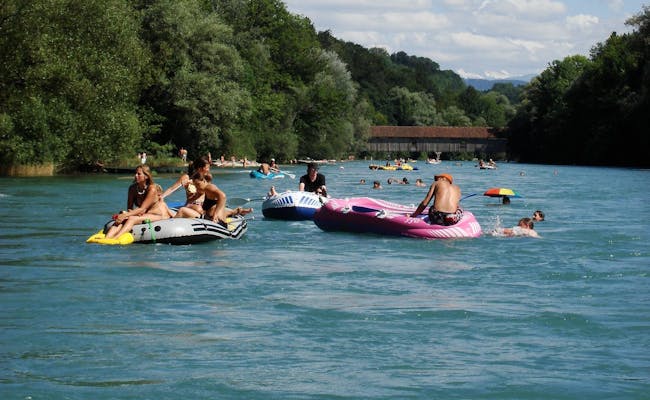 Rhein
Rhein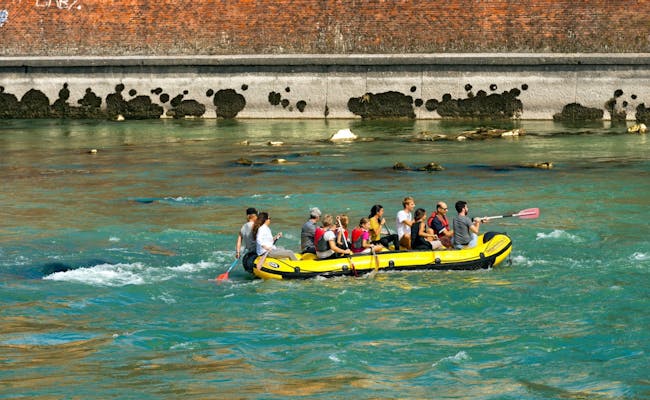 Stein am Rhein
Stein am RheinTicino Rafting
The Ticino river is channelized in the last kilometers before flowing into Lake Maggiore, and it flows particularly smoothly. The banks are reinforced, and reed beds line the river towards the lake. Here, the current also eases. After disembarking, you can enjoy a sundowner at the beach bar.
The tours run either between Cresciano and Bellinzona or Bellinzona and Magadino, lasting 1.5 and 2.5 hours for 10 and 16 kilometers, respectively. The Ticino river is also known as Tessin. The Tessin mountains stand majestically above you during the rafting.
The water level at Bellinzona is ideal for rafting, ranging from 15-100 m3/s.
The initially wild Ticino from Cresciano passes by gravel banks and wooded slopes inviting for a barbecue. Rafting is not recommended at low water levels.
Entry Points for Ticino Rafting
In Cresciano, a path leads down to the shore below the sports field to the launching spot. You can get there from Bellinzona via Castione to the Cresciano, Paese bus stop. Then continue on foot.
You can reach the entry point Bellinzona by going to the bridge from the bus stop "Bellinzona, Via Lepori". From there, you can access the water directly.
Hazard Areas While Rafting on the Ticino
Shortly after the entry in Cresciano, there are a few rapids. Watch out for venomous vipers between the rocks, and just after the Passerella di Claro-Gnosca on the left, there is a rock barrier.
On the stretch between Bellinzona and Magadino, besides a few large rock formations in the water, there are no hazardous areas.
Exit Points for Ticino Rafting
The exit point Bellinzona is situated close to a bus stop. You can also exit at Arbedo. In Arbedo, the Moësa river joins the Ticino after the motorway bridge, and you can disembark right after the confluence on the left. From the exit point, it's about a 10-minute walk to the Arbedo, Molinazzo bus stop.
Magadino is already in Lake Maggiore. As soon as you arrive over the Ticino in Lake Maggiore, head towards the white church of Magadino. Below it is a small peninsula where you can disembark. The bus stop "Magadino, Casa Comunale" is just a few steps up the main road.
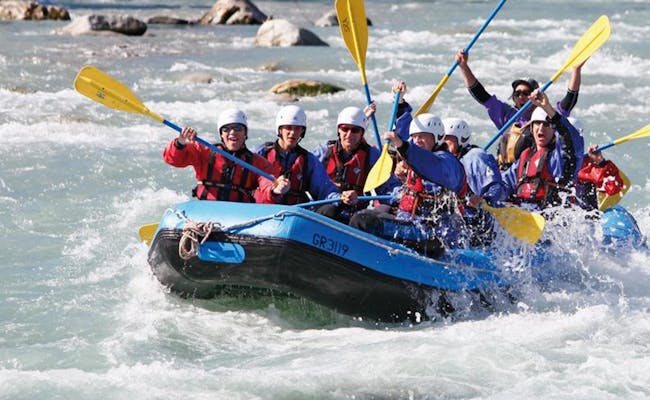 Ticino Swissraft (Photo Swissraft Ticino Tourism Agency ATT SA)
Ticino Swissraft (Photo Swissraft Ticino Tourism Agency ATT SA)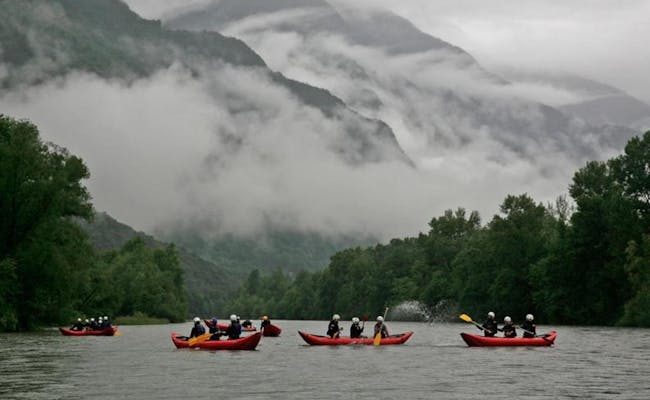 Ticino Swissraft (Photo Swissraft Ticino Tourism Agency ATT SA)
Ticino Swissraft (Photo Swissraft Ticino Tourism Agency ATT SA)Glatt-Boating
The Glatt is only 38.5 km long, but it’s long enough for a nice boat trip through nature. The river drains the Greifensee into the Rhine. The about eight-kilometer stretch between Rümlang and Oberhöri is great for a rubber boat ride, but there’s also a spot to get out in Oberglatt halfway through. Overall, the trip takes about three hours. You can use an interesting article with a little map for preparation.
The ride goes along Zurich Airport and offers unique views of arriving and departing planes of all kinds. The nature reserve and the east-west runway of the airport create a nice contrast. The river bends from Oberglatt to Niederglatt are particularly beautiful.
Entry Points for Boating on the Glatt
In Rümlang, you walk from the train station to the Garbabrücke, following the signs towards the Glatt riverside paths. Then, you can launch your boat down the stairs to the right of the Garbabrücke on Klotenerstrasse.
Hazard Spots while Boating on the Glatt
Under the railway bridge at Niederglatt, you need to be prepared for stronger currents.
Exit Points for Boating on the Glatt
In Oberglatt, after leaving the airport area, head right after the wooden Hirschenbrücke. Just before that, the Himmelbach river joins in. After the mud silos of the Fischbach-Glatt sewage treatment plant, the last exit comes up. You’ll leave the Glatt on the left side under the road bridge at the bike path. Due to several weirs and structures with stone blocks, it’s not possible to continue from Oberhöri.
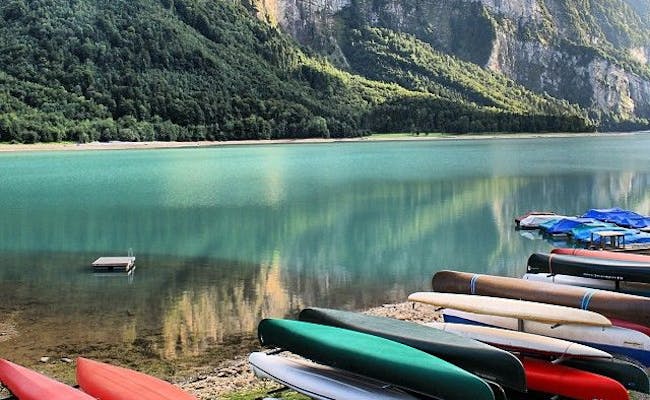 Glatt
Glatt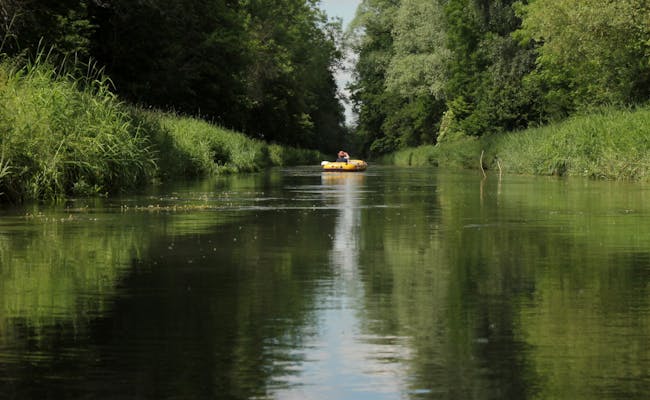 Glatt
GlattLinth-Boat Trip
A rubber boat trip over the renatured canal between Weesen and Schmerikon is pure relaxation. The Linth connects the two lakes Walensee and Obersee/Zürichsee, partly via the Linth Canal, which is completely free of special danger spots.
The tours between Weesen or Ziegelbrücke and the Benken-Giessen island (15 km) or from Benken-Giessen to Schmerikon (7.2 km) can be combined in any way. Grynau (Uznach) is also a suitable entry and exit point. Between Grynau and Schmerikon, you have to paddle pretty well for about 35 minutes.
Entry Points for Linth-Boat Trip
- The Ziegelbrücke in Niederurnen is very well accessible by public transport via regional train and S-Bahn. The train station is just a few steps away. Here, S2, S4, S6, and S8 stop. There is also a large parking lot available.
- On Benken Island, Giessen at the bathing area right below the Sternen restaurant, reachable with bus 365. The Sternen restaurant offers "food to go".
- In Grynau (Uznach) in front of the bridge and the Grynau restaurant.
Danger Spots on the Linth-Boat Trip
There are no critical danger spots.
Exit Points for Linth-Boat Trip
- On Benken Island, Giessen at the bathing area right below the Sternen restaurant are the landing spots for boats. Bus 365 goes back to Ziegelbrücke.
- At Schloss Grynau (Uznach), you can take a break or end the trip. The boat can be tied at the marked spots.
- On the right lakeshore of Obersee lies the village Schmerikon. Here, you aim for the lakeside promenade. The train station is not far away; it is right above.
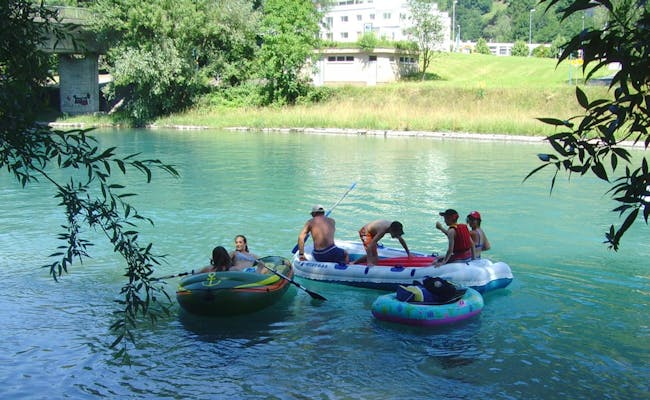 Zürich
Zürich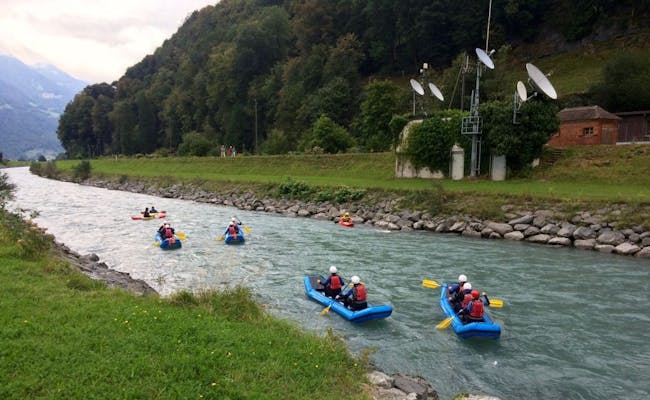 Reuss Linth
Reuss LinthRhone Boating
You can use the Rhône for a little boating in Geneva between the Pont Sous-Terre Bridge and Le Lignon. Alongside pretty and romantic bridges, you also have the striking backdrop of huge apartment blocks that create a unique contrast.
The ride takes you past the Jonction peninsula, where the Arve flows from the Mont-Blanc massif and joins the Rhône from Lake Geneva. After passing majestic cliffs on your right, you'll eventually get by the Cité du Lignon.
This is a colossal complex, with its main section being the longest residential building in Switzerland at 980 meters. The boating trip takes about two to three hours over the 5.5 km route.
Entry Points for Rhôna Boating
You can enter via a concrete ramp at the Pont Sous-Terre Bridge. If you're coming from Geneva, take the train to Geneva, then catch Bus Line 7 (heading towards "Vernier, Lignon-Tour") to "Délices". From there, walk straight to the Pont Sous-Terre Bridge.
Hazardous Areas While Boating on the Rhône
During weekdays, a large waste collection boat operates on this stretch of the river three times a week; in that case, stay close to the shore.
Exit Points for Rhôna Boating
The exit is on the right by the footbridge known as the Passerelle du Lignon. From here, you can reach the bus stop "Vernier, Lignon-Cité" via the footpath to the Le Lignon settlement in about ten minutes. Bus Line 7 runs every 15 minutes to Geneva.
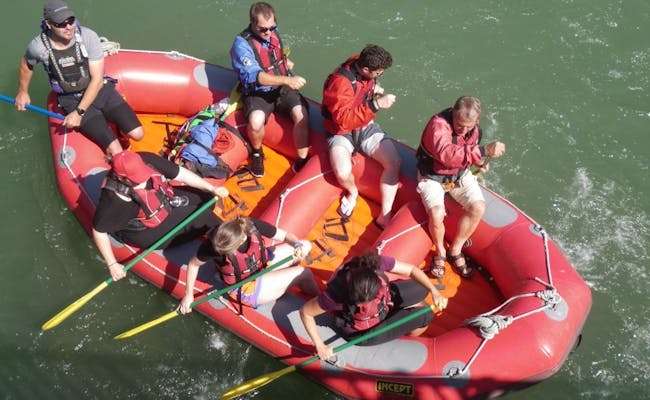 Reuss
Reuss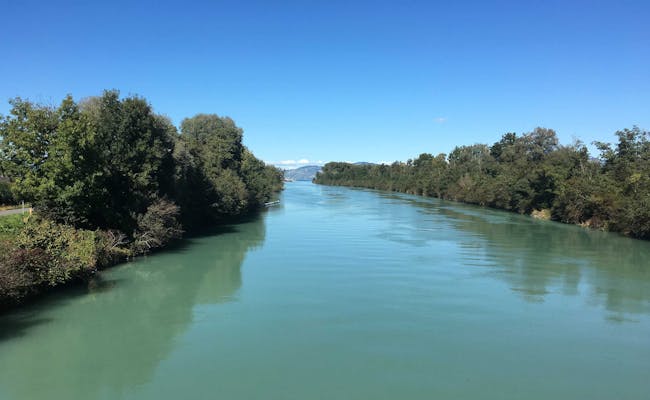 Rhone
RhoneRheintal-Boat Trip
On the Rheintal Inland Canal, you can paddle between Montlingen in St. Gallen all the way to Au, covering about 12 km on the shallow canal, without any hazards. You’ll enjoy the Bregenz Forest Mountains during the trip, which takes about three to four hours.
You’ll cross a former peat bog, now the Bannriet Nature Reserve. There’s a spot to land at a staircase on the left bank. Here, you'll find some shady trees and a grill area. Until you reach Au, the current is strong enough that you hardly need to paddle.
If you want, you can extend the boat trip another two kilometers to St. Margrethen, or even another 6 km to the mouth of the lake at Marina Altenrhein. However, the last few kilometers are very shallow and often blocked by trees. For this, you’ll need flat military inflatable boats, which can be rented from Steigmatt-Hof in Montlingen.
Entry Points for Boat Trips on the Rheintal
- right below the small power plant Montlingen
Hazard Areas during the Rheintal Boat Trip
- none, but the water is very cold and not suitable for swimming
- the canal can be waded through if necessary (80 cm deep)
- caution with anglers
Exit Points for Boat Trips on the Rheintal
- The staircase on the right side before the steel arch bridge at the Au train station is a good place to land.
- At Bruggerhorn in St. Margrethen

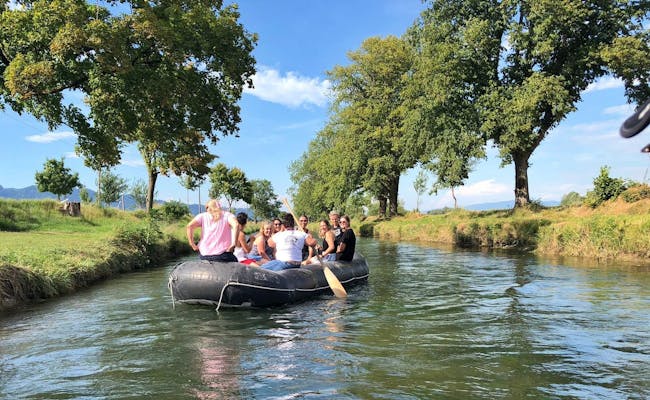
Thur-Boat Trip
The Thur is considered a wild stream and is partially suitable for a boat trip. The Thur on the way to the High Rhine is especially scenic. A really nice stretch goes from Gütighausen to Andelfingen. You’ll need about three hours to cover nearly ten km. If you’re not done yet, you can just keep going. In Flaach, you’ll find the last place to get out before flowing into the Rhine. After that, due to the Thurauen nature reserve before the inflow into the High Rhine, there’s no more exit point. Swimming is also not allowed here. The next exit is then in Rüdlingen after a total of 17 km and 4.5 hours.
The water level can rise quickly in the last section of the river after heavy rain in the source area. The recommended water flow rate is between 10 and 100 m3/s.
Entry Points for a Thur-Boat Trip
- Gütighausen left riverbank at Asperhof (Thur parking lot)
- before the Thur Bridge in Gütighausen on the right riverbank; this spot is commonly used and the parking lot is often very full (if there’s no parking left at the bridge, you can drive about 80 m further right to a field strip), it’s easy to launch here
Hazard Areas during the Thur-Boat Trip
- From Gütighausen, the Thur can be easily navigated, there are no hazards, just a few river bends and small rapids to watch out for
- The Thurgau cantonal police has issued a brochure for the Thur-Boat Trip. It strongly warns against navigating the stretch between the Altiker Bridge in Altikon and the Thurgau border. However, it’s safe to navigate from the height of Asperhof / Gütighausen.
- At Thurspitz, the inflow into the High Rhine, whirlpools are possible.
Exit Points for a Thur-Boat Trip
- Wooden bridge in Andelfingen (with connection to public transport, there are hardly any parking spots) you can launch at the campsite on the right or at the slipway
- Andelfingen Pünten left launch point (large parking lot)
- Andelfingen Old Thur Bridge left launch point (parking lot)
- Flaach Thur Bridge right last exit point before the Rhine inflow, parking is available but scattered further away in the woods
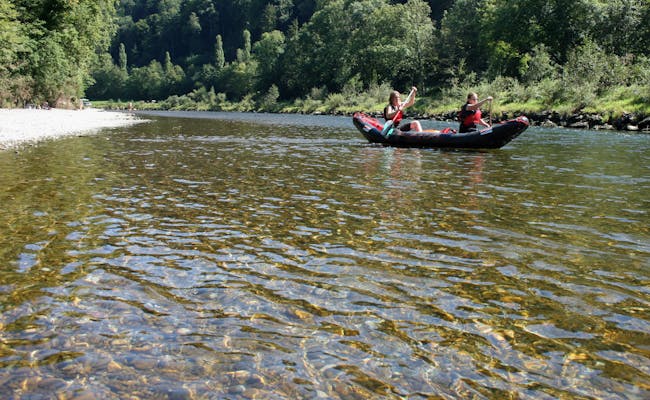 Thur
Thur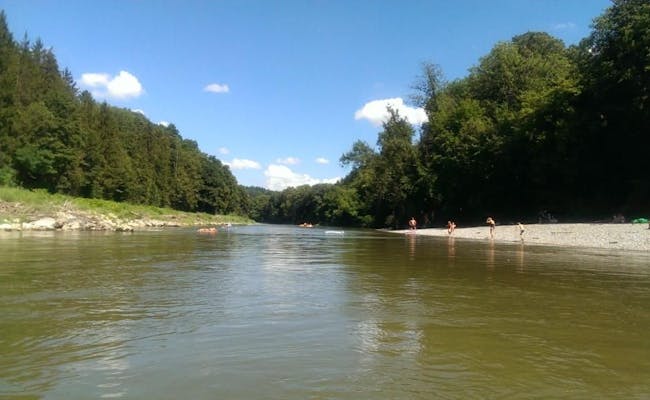 Thur Sonnenhof bei Dätwil
Thur Sonnenhof bei DätwilPhotos Source:
- aarelauf.ch
- marinatravel.ch
- regionale2025.ch
- stoecklisport.ch
- city-zuerich.ch
- Ticino Tourism Agency (ATT SA)
- Bern Welcome
- Stephan Regli

